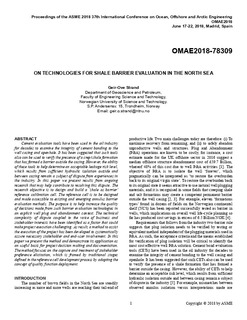On technologies for shale barrier evaluation in the North Sea
Chapter
Accepted version

Åpne
Permanent lenke
http://hdl.handle.net/11250/2593257Utgivelsesdato
2018Metadata
Vis full innførselSamlinger
Originalversjon
10.1115/OMAE2018-78309Sammendrag
Cement evaluation tools have been used in the oil industry for decades to examine the integrity of cement bonding to the well casing and openhole. It has been suggested that such tools also can be used to verify the presence of a crept shale formation that has formed a barrier outside the casing. However, the ability of these tools to help determine an acceptable leakage risk level, which results from sufficient hydraulic isolation outside and between casing remain a subject of dispute from experiences in the industry. In this paper we present results from ongoing research that may help contribute to resolving this dispute. The research objective is to design and build a ’shale as barrier’ reference calibration cell. The reference cell is to be designed and made accessible to existing and emerging annulus barrier evaluation methods. The purpose is to help increase the quality of decisions made from such barrier evaluation technologies in an explicit well plug and abandonment context. The technical complexity of dispute coupled to the voice of business and stakeholder interests have been identified as a factor that could make project execution challenging. As result, a method to assist the execution of the project has been developed to systematically assure necessary stakeholder and end-user involvement. In this paper we present the method and demonstrate its application as an useful basis for project decision making and documentation. The method focuses on the capture and treatment of stakeholder preference elicitation, which is framed by traditional stages defined in the reference cell development process by adopting the concept of quality function deployment.